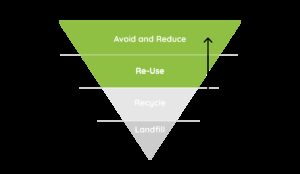How to Make your Business More Sustainable
A guide on how to make your business more sustainable to help reduce long term costs, improve your reputation and create new commercial opportunities.
Last updated: Jul 26, 2024 • 5 min read

Summary
These are some of the key tactics you can employ to reduce your organisation's impact on the environment:
- Switch your fleet to electric vehicles.
- Efficiently manage your resources and waste.
- Sustainably manage your supply chain.
- Optimise your energy efficiency.
- Adopt green and renewable technologies.
Switch your fleet to electric vehicles
No surprises to see us lead with electrification of vehicles, but with emissions from power generation falling fast, the transport sector is the most significant contributor to both CO2 emissions as well as air pollution in the UK.
In 2017, CO2 emissions from the transport sector accounted for 34% of all CO2 emissions with passenger cars the most significant contributor. Emissions were broadly unchanged from 2016.
By switching your fleet to electric you can cut your operational emissions by up to 70%, and with grid emissions falling, this saving improves each year.
Installing charging stations at your workplace is a key enabler to operating an electric fleet, but can also encourage your staff to commute in electric cars, significantly reducing their environmental impact.
As more electric vehicles are coming to market including 4x4s, vans and longer range passenger cars, it’s getting easier and easier to substitute your existing fleet vehicles with electric versions.
Tip: Electrification represents a huge improvement in the sustainability of cars but enabling and encouraging staff to commute on foot or by bicycle will always be the most sustainable options. Remote working and virtual meetings can also reduce unnecessary travel and resultant emissions.
Efficiently manage your resources and waste
While many consider recycling to be the pinnacle of “eco friendly” office practices, it is in fact the second worst option in the “waste hierarchy”. Of course, recycling is important, but when considering ways to reduce the environmental impact of your business activities and supply chain, it is best to take a holistic view.
The Waste Hierarchy

1. Avoid and Reduce
Definitely the best approach to efficient resource use is to stop buying material that you only intend to throw out.
Best practice examples include operating a paperless office, declining unnecessary packaging or choosing suppliers who commit to minimising packaging.
2. Reuse
Next best is to reuse the materials your business obtains. At an individual level this can be committing to the use of reusable water bottles and refillable cups for take away coffees instead of disposable cups.
It can also mean implementing business-wide policies to recover valuable office supplies, rather than disposing of them. From avoiding disposable cutlery and cups in the office, to implementing reconditioning processes for faulty equipment.
3. Recycle
Recycling should be a priority for any business committed to sustainable practices. Inevitably waste is generated through packaging etc and having readily available, clearly labelled recycling bins, together with regular staff training helps optimise its effectiveness.
4. Landfill Avoidance
The most wasteful use of resources is to simply bury them in big holes in the ground when they are no longer needed. The amount of material that meets this fate should be absolutely minimised.
Tip: Not all packaging is created equal! The environmental impact of biodegradable, compostable packaging is far less than that of plastics if disposed of correctly.
Sustainably manage your supply chain
Choosing sustainably sourced and supplied materials for your business can significantly improve the sustainability of your overall business operations.
You can seek suppliers who meet various accreditations (e.g. Pod Point’s main suppliers operate an ISO14001 accredited Environmental Management System), but equally you can drive down your emissions by making practical choices.
For example, astute supply chain management can ensure that components sourced from overseas can be shipped, rather than flown at short notice, reducing their Carbon footprint.
Optimise your energy efficiency
This is perhaps the biggest no brainer in the world of sustainability, simply select the products that are the most efficient, not only will this make your commercial operations more sustainable, it will also save your business money.
Examples of more energy-efficient products include:
- Switching to LED lighting with motion sensors and timers.
- Ensuring effective insulation of buildings.
- Installing efficient plumbing and associated devices.
Tip: The world faces challenges in meeting our carbon reduction targets and many technological solutions are still to be determined. However, whatever path we take, delivering energy efficiency improvements should be our first action - reducing the scale of the challenge.
Adopt green and renewable technologies
Alongside electrifying your vehicles, perhaps the coolest approach to sustainability is to invest in your own renewable energy microgeneration technologies.
As costs fall, microgeneration technologies are becoming more viable for a growing number of businesses, whilst some rather lower-tech options remain worth exploring.
Examples of these include:
- Solar photovoltaic cells
- Battery storage
- Ground / air source heat pumps
- Green roofs
- Wind turbines (viability is questionable at small scale)
Tip: The intermittency of renewable energy generation makes battery storage a particularly exciting prospect. While costs make battery storage commercially impractical for many at present, the fast falling cost of manufacture will make both EVs and fixed storage batteries viable for many through the early 2020s.
Tip: While not a controllable factor for many business owners, our diets have a significant impact on our carbon footprint. Plant-based foodstuffs require far fewer resources in their production and are therefore more environmentally sustainable.
